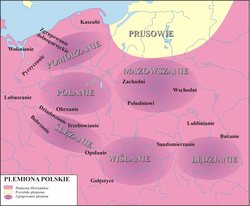The Silesians (Polish: Ślężanie) were a tribe of West Slavs, specifically of the Lechitic/Polish group, inhabiting territories of Lower Silesia, near Ślęża mountain and Ślęza river, on both banks of the Oder, up to the area of modern city of Wrocław. They were the first permanent inhabitants of the site of Wrocław where they build a fort on Ostrów Tumski in the 9th century or earlier, which at the time was an island on the Oder.
Their tribal name was derived from the name of the mountain and the river, which most likely came from the old Polish word Ślagwa, meaning "humid", which refers to the climate of the area. The name of the region in turn, Silesia, comes from their language and tribal name. Along with the Opolans, the Ślężanie comprised one of the two major tribes in Silesia. They bordered the Dziadoszanie to their north. The Biezunczanie's territory lay to the west. Other, more minor, Silesian tribes of the time included the Golensizi, Trzebowianie (who might have actually been part of the Ślężanie), Bobrzanie (who were probably subjects of the Dziadoszanie) and the Głubczyce, further to the south.

The Bavarian Geographer, which refers to them as the Sleenzane, states that they had 15 settlements, or gords (civitates), and lists them as one of several tribes located in Silesia. The Prague charter (description of borders of the Prague bishopric) from 1086 refers to them with the alternative name of Zlasane. Thietmar's Chronicle, from the second decade of the 11th century, calls them the Silensi. Their tribal name was known to the Franks and the Byzantines.
The Ślężanie achieved a high degree of social organization and built fortified towns by the 8th century AD, if not earlier. Archeological finds of fortifications built by various Silesian tribes date back to as early as 4th century and evidence of continuous settlement in the area can be traced back to 1st century AD.
A long fortified wall, strengthened by numerous moats, stretched from the present day town of Jelenia Góra to Krosno Odrzańskie, and along both sides of the Bobr river. The existence of these sophisticated defenses suggests that the various Silesian tribes had to cooperate in their construction. Hence, it is possible that in the period between the 7th and 9th centuries, the Ślężanie were united in a loose confederation of Silesian tribes. However, the wall most likely served a solely defensive purpose, most likely as a bulwark against raiding parties of the neighboring Polabian Slavs as none of the Polish tribes yet shared direct borders with Germanic states at the time.
From 990 AD on, after a series of short wars between Mieszko I of the Piast dynasty, first ruler of Poland, and Boleslaus II, Duke of Bohemia of the Přemyslid dynasty (who was Mieszko's brother in law), Silesia, and the Ślężanie, became part of the Polish state. Over time, the Ślężanie, along with the other Silesian tribes, as well as the Vistulans, Pomeranians, Lendians, Masovians and the Polans mixed and became part of the Polish state.
The mountain Ślęża, and the neighboring peak of Sępia Góra ("Vulture Peak"), served as a sacred place where important religious ceremonies were held by the tribe. In fact, the religious importance of the location dates back to the sun-worshipping people of the Lusatian culture, as early as 1300 B.C. It was used as a place of worship by various people who inhabited the area before the Ślężanie, for example, the Silingi (most likely a Vandal tribe). The mountain Ślęża was also a place of pilgrimage for other Slavic tribes of that era. According to legend, the peak was created as a result of a battle between angels and demons, when after a struggle, the angels used the mountain to bury the entrance to hell.
See also
Notes
- ^ Jasienica, pg. 32
- Wieczorek and Hinz, pg. 155
- ^ Wroclaw-life.com, Cathedral Isle
- Krzysztof Dydyński, Poland: a travel survival kit, Lonely Planet Publications, 1993
- ^ Jasienica, pg. 35
- ^ Buko, pgs. 83-84
- Koemer and Szwedek, pg. 133
- Lerski, Wróbel and Kozicki, pg. 354
- Falk, pg. 546
- Krzysztof Kucharski, "Menu dawnych Ślężan" (Menu of the old Ślężanie), Gazeta Wroclawska, 13 August 2009, last accessed July 8, 2010,
References
- Andrzej Buko (2008). The Archaeology of Early Medieval Poland: Discoveries, Hypotheses, Interpretations. BRILL. pp. 83–. ISBN 978-90-04-16230-3.
- Avner Falk (1996). A Psychoanalytic History of the Jews. Fairleigh Dickinson Univ Press. pp. 547–. ISBN 978-0-8386-3660-2.
- E. F. K. Koerner; A. J. Szwedek (2001). Towards a History of Linguistics in Poland: From the Early Beginnings to the End of the Twentieth Century. John Benjamins Publishing. pp. 171–. ISBN 90-272-4591-6.
- Jerzy Jan Lerski (1996). Historical Dictionary of Poland, 966-1945. Greenwood Publishing Group. ISBN 978-0-313-26007-0.
- Alfried Wieczorek; Hans-Martin Hinz (2000). Europe's centre around AD 1000. Stuttgart: Theiss. ISBN 978-3-8062-1549-6.
| Tribes mentioned in the Bavarian Geographer | |
|---|---|
| |
| The tribes are listed according to the original names and order |
| Early Slavic ethnic groups (7th–12th centuries) | |||||||||||
|---|---|---|---|---|---|---|---|---|---|---|---|
| East Slavs |
| ||||||||||
| West Slavs | |||||||||||
| South Slavs |
| ||||||||||
| |||||||||||